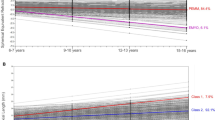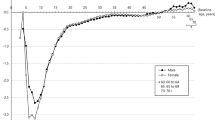Abstract
The objective herein is to provide refraction data, myopia progression rate, prevalence, and 1st and 2nd generation correlations, relevant to whether myopia is random or inherited. First- and second-generation ocular refraction data are assembled from N = 34 families, average of 2.8 children per family. From this group, data are available from N = 165 subjects. Inter-generation regressions are performed on all the data sets, including correlation coefficient r, and myopia prevalence [%]. Prevalence of myopia is [M] = 38.5 %. Prevalence of high myopes with |R| >6 D is [M−] = 20.5 %. Average refraction is <R> = −1.84 D ± 3.22 (N = 165). For the high myopes, |R| >6 D, prevalence for the parents is [M−] = 25 %, for the 2nd generation [M−] = 16.5 %. Average myopia level for the high myopes, both generations, is <S> = −7.52 D ± 1.31 D (N = 33). Regression parameters are calculated for all the data sets, yielding correlation coefficients in the range r = 0.48–0.72 for some groups of myopes and high myopes, fathers to daughters, and mothers to sons. Also of interest, some categories show essentially no correlation, −0.20 < r < 0.20, indicating that the refractive errors occur randomly. Time series results show myopia diopter rates = −0.50 D/year.






Similar content being viewed by others
References
Vitale S, Sperduto RD, Ferris FL III (2009) Increased prevalence of myopia in the United States between 1971–1972 and 1999–2004. Arch Ophthalmol 127(12):1632–1639
Saw SM, Tong L, Chua WH, Chia KS, Koh D, Tan DT, Katz J (2005) Incidence and progression of myopia in Singaporean school children. Invest Ophthalmol Vis Sci 46(1):51–57
Fan DS, Lam DS, Lam RF, Lau JT, Chong KS, Cheung EY, Lai RY, Chew SJ (2004) Prevalence, incidence, and progression of myopia of school children in Hong Kong. Invest Ophthalmol Vis Sci. 45(4):1071–1075
Lin LL, Shih YF, Lee YC, Hung PT (1996) Hou PK Changes in ocular refraction and its components among medical students–a 5-year longitudinal study. Optom Vis Sci 73(7):495–498
Greene PR, Vigneau ES, Greene J (2015) Exponential prevalence and incidence equations for myopia. Clin Exp Optom. 98(3):210–213
Greene PR, Grill ZW, Medina A (2016) Mathematical models of college myopia. Optics 127(2):896–899. doi:10.1016/j.ijleo.2015.10.190
Greene PR, Grill ZW, Medina A (2015) Exploring reading glasses to stabilize college myopia. JSM Ophthalmol 3(3):1034
Mutti DO (2010) Hereditary and environmental contributions to emmetropization and myopia. Optom Vis Sci 87(4):255–259
Zadnik K, Satariano WA, Mutti DO, Sholtz RI, Adams AJ (1994) The effect of parental history of myopia on children’s eye size. JAMA 271(17):1323–1327
Kurtz D, Hyman L, Gwiazda JE, Manny R, Dong LM, Wang Y, Scheiman M, COMET Group (2007) Role of parental myopia in the progression of myopia and its interaction with treatment in COMET children. Invest Ophthalmol Vis Sci 48(2):562–570
Jones-Jordan LA, Sinnott LT, Manny RE, Cotter SA, Kleinstein RN, Mutti DO, Twelker JD, Zadnik K (2010) Early childhood refractive error and parental history of myopia as predictors of myopia. Collaborative longitudinal evaluation of ethnicity and refractive error (CLEERE) study group. Invest Ophthalmol Vis Sci 51(1):115–121
Fledelius HC (2000) Myopia profile in copenhagen medical students 1996–1998. refractive stability over a century is suggested. Acta Ophthalmol Scand 78(5):501–505
Medina A, Fariza E (1993) Emmetropization as a first-order feedback system. Vis Res 33(1):21–26
Greene PR, Brown OS, Medina AP, Graupner HB (1996) Emmetropia approach dynamics with diurnal dual-phase cycling. Vis Res 36(15):2249–2251
Medina A (2015) The progression of corrected myopia. Graefes Arch Clin Exp Ophthalmol 253(8):1273–1277
Medina A, Greene PR (2015) Progressive myopia and lid suture myopia are explained by the same feedback process: a mathematical model of myopia. J Nat Sci 1(6):e121
Medina A (2015) Detecting the effect of under-correcting myopia. Graefes Arch Clin Exp Ophthalmol [Epub ahead of print]
Lopes MC, Andrew T, Carbonaro F, Spector TD, Hammond CJ (2009) Estimating heritability and shared environmental effects for refractive error in twin and family studies. Invest Ophthalmol Vis Sci 50(1):126–131
Visscher PM, Hill WG, Wray NR (2008) Heritability in the genomics era–concepts and misconceptions. Nat Rev Genet 9(4):255–266
Wu LJ, You QS, Duan JL, Luo YX, Liu LJ, Li X, Gao Q, Zhu HP, He Y, Xu L, Jonas JB, Wang W, Guo XH (2015) Prevalence and associated factors of myopia in high-school students in Beijing. Plos One 10(3):e0120764
Wang TJ, Chiang TH, Wang TH, Lin LL, Shih YF (2009) Changes of the ocular refraction among freshmen in National Taiwan University between 1988 and 2005. Eye (Lond) 23(5):1168–1169
Lin LL, Shih YF, Hsiao CK, Chen CJ (2004) Prevalence of myopia in Taiwanese schoolchildren: 1983–2000. Ann Acad Med Singap 33(1):27–33
Dirani M, Shekar SN, Baird PN (2008) Evidence of shared genes in refraction and axial length: the genes in myopia (GEM) twin study. Invest Ophthalmol Vis Sci 49(10):4336–4339
Sanfilippo PG, Hewitt AW, Hammond CJ, Mackey DA (2010) The heritability of ocular traits. Surv Ophthalmol 55(6):561–583
Cheng CY, Schache M, Ikram MK, Young TL, Guggenheim JA, Vitart V et al (2013) Nine loci for ocular axial length identified through genome-wide association studies, including shared loci with refractive error. Am J Hum Genet 93(2):264–277
Bullimore MA, Jones LA, Moeschberger ML, Zadnik K, Payor RE (2002) A retrospective study of myopia progression in adult contact lens wearers. Invest Ophthalmol Vis Sci 43(7):2110–2113
Guggenheim JA, St Pourcain B, McMahon G, Timpson NJ, Evans DM, Williams C (2015) Assumption-free estimation of the genetic contribution to refractive error across childhood. Mol Vis 21:621–632
Pacella R, McLellan J, Grice K, Del Bono EA, Wiggs JL, Gwiazda JE (1999) Role of genetic factors in the etiology of juvenile-onset myopia based on a longitudinal study of refractive error. Optom Vis Sci 76(6):381–386
Author information
Authors and Affiliations
Corresponding author
Ethics declarations
Conflict of interest
The authors have no proprietary or financial conflicts of interest.
Appendix I: Regression statistics N = 165 subjects
Appendix I: Regression statistics N = 165 subjects
Inter-generation refraction correlations:
-
(1)
Father Rf to sons Rs:
Rs = 0.20 * Rf −1.39 D. [σ = ± 2.97 D, r = 0.212, N = 49]
-
(2)
Father Rf to daughters Rd:
Rd = 0.23 * Rf −1.29 D. [σ = ± 3.10 D, r = 0.267, N = 48]
-
(3)
Mother Rm to sons Rs:
Rs = −0.08 * Rm −1.92 D [σ = +/−3.02 D, r = −0.080, N = 49]
-
(4)
Mother Rm to daughters Rd:
Rd = 0.35 * Rm −1.45 D. [σ = ±2.94 D, r = 0.356, N = 48]
Figure 6.
Rights and permissions
About this article
Cite this article
Greene, P.R., Medina, A. Refraction data survey: 2nd generation correlation of myopia. Int Ophthalmol 36, 609–614 (2016). https://doi.org/10.1007/s10792-016-0172-0
Received:
Accepted:
Published:
Issue Date:
DOI: https://doi.org/10.1007/s10792-016-0172-0




